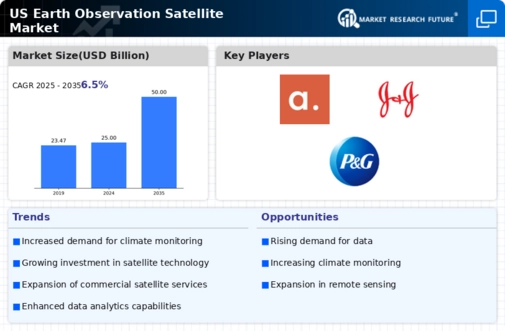The earth observation satellite market is characterized by a dynamic competitive landscape, driven by advancements in technology, increasing demand for data analytics, and a growing emphasis on sustainability. Key players such as Maxar Technologies (US), Planet Labs (US), and Northrop Grumman (US) are strategically positioned to leverage these trends. Maxar Technologies (US) focuses on high-resolution imagery and geospatial data analytics, while Planet Labs (US) emphasizes rapid satellite deployment and data accessibility. Northrop Grumman (US) is enhancing its capabilities through innovative satellite systems and partnerships with governmental agencies. Collectively, these strategies foster a competitive environment that prioritizes technological innovation and responsiveness to market needs.
In terms of business tactics, companies are increasingly localizing manufacturing and optimizing supply chains to enhance operational efficiency. The market structure appears moderately fragmented, with several players vying for market share. However, the influence of major companies is substantial, as they set industry standards and drive technological advancements. This competitive structure encourages collaboration and innovation, as smaller firms often partner with larger entities to access resources and expertise.
In November 2025, Maxar Technologies (US) announced a partnership with NASA (US) to develop advanced Earth observation capabilities aimed at climate monitoring. This collaboration is strategically significant as it aligns with global sustainability goals and enhances Maxar's position as a leader in environmental data provision. The partnership is expected to yield innovative solutions that address pressing climate challenges, thereby reinforcing Maxar's market presence.
In October 2025, Planet Labs (US) launched a new satellite constellation designed to provide daily global coverage. This strategic move is crucial as it enhances the company's data acquisition capabilities, allowing for more timely and relevant insights for various industries, including agriculture and urban planning. The ability to deliver frequent updates positions Planet Labs favorably against competitors, potentially increasing its market share.
In September 2025, Northrop Grumman (US) secured a contract with the U.S. Department of Defense to develop next-generation satellite systems. This contract underscores Northrop Grumman's commitment to innovation and its strategic focus on defense applications. The implications of this contract extend beyond immediate revenue, as it solidifies the company's reputation as a key player in national security and defense-related earth observation technologies.
As of December 2025, current competitive trends in the earth observation satellite market include a pronounced shift towards digitalization, sustainability, and the integration of artificial intelligence (AI) in data processing. Strategic alliances are increasingly shaping the landscape, as companies recognize the value of collaboration in enhancing technological capabilities. Looking ahead, competitive differentiation is likely to evolve from traditional price-based competition to a focus on innovation, advanced technology, and supply chain reliability. This shift suggests that companies that prioritize these aspects will be better positioned to thrive in an increasingly complex market.














Leave a Comment